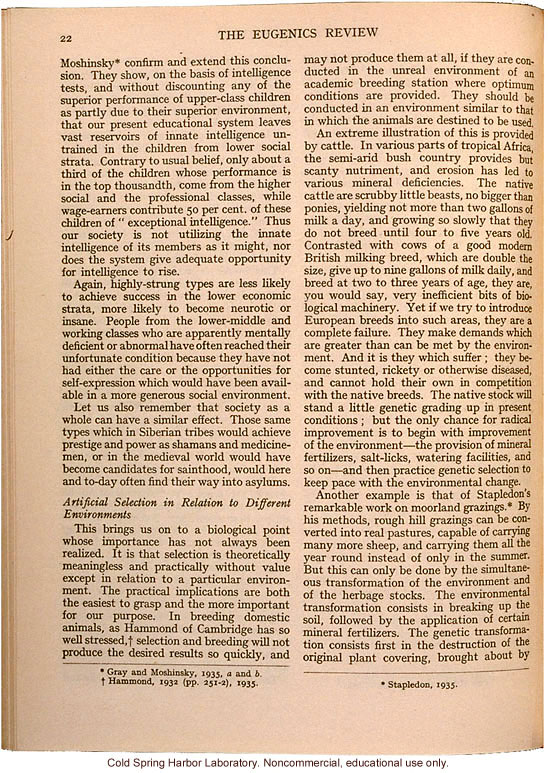22 The Eugenics Review
Moshinsky* confirm and extend this conclusion. They show, on the basis of intelligence tests, and without discounting any of the superior performance of upper-class children as partly due to their superior environment, that our present educational system leaves vast reservoirs of innate intelligence untrained in the children from lower social strata. Contrary to usual belief, only about a third of the children whose performance is in the top thousandth, come from the higher social and the professional classes, while wage-earners contribute 50 per cent. of these children of "exceptional intelligence." Thus our society is not utilizing the innate intelligence of its members as it might, nor does the system give adequate opportunity for intelligence to rise.
Again, highly-strung types are less likely to achieve success in the lower economic strata, more likely to become neurotic or insane. People from the lower-middle and working classes who are apparently mentally deficient or abnormal have often reached their unfortunate condition because they have not had either the care or the opportunities for self-expression which would have been available in a more generous social environment.
Let us also remember that society as a whole can have a similar effect. Those same types which in Siberian tribes would achieve prestige and power as shamans and medicine-men, or in the medieveal world would have become candidates for sainthood, would here and to-day often find their way into asylums.
[italics]Artificial Selection in Relation to Different Environments[end italics]
This brings us on to a biological point whose importance has not always been realized. It is that selection is theoretically meaningless and practically without value except in relation to a particular environment. The practical implications are both the easiest to grasp and the more important for our purpose. In breeding domestic animals, as Hammond of Cambridge has so well stressed, [dagger] selection and breeding will not produce the desired results so quickly, and may not produce them at all, if they are conducted in the unreal environment of an academic breeding station where optimum conditions are provided. They should be conducted in an environment similar to that in which the animals are destined to be used.
An extreme illustration of this is provided by cattle. In various parts of tropical Africa, the semi-arid bush country provides but scanty nutriment, and erosion has led to various mineral deficiencies. The native cattle are scrubby little beasts, no bigger than ponies, yielding not more than two gallons of milk a day, and growing so slowly that they do not breed until four or five years old. Contrasted with cows of a good modern British milking breed, which are double the size, give up to nine gallons of milk daily, and breed at two to three years of age, they are, you would say, very inefficient bits of biological machinery. Yet if we try to introduce European breeds into such areas, they are a complete failure. They make demands which are greater than can be met by the environment. And it is they which suffer; they become stunted, rickety or otherwise diseased, and cannot hold their own in competition with the native breeds. The native stock will stand a little genetic grading up in present conditions; but the only chance for radical improvement is to begin with improvement of the environment - the provision of mineral fertilizers, salt-licks, watering facilities, and so on - and then practice genetic selection to keep pace with the environmental change.
Another example is that of Stapledon's remarkable work on moorland grazings.* By his methods, rough hill grazings can be converted into real pastures, capable of carrying many more sheep, and carrying them all the year round instead of only in the summer. But this can only be done by the simultaneous transformation of the environment and of the herbage stocks. The environmental transformation consists in breaking up the soil, followed by the application of certain mineral fertilizers. The genetic transformation consists first in the destruction of the original plant covering, brought about by
[left side column-width hairline rule]
[footnotes]
*Gray and Moshinsky, 1935, [italics]a[end italics] and [italics]b[end italics].
[dagger]Hammond, 1932 (pp. 251-2), 1935.
[right side column-width hairline rule]
[footnote]*Stapledon, 1935.
[end]


